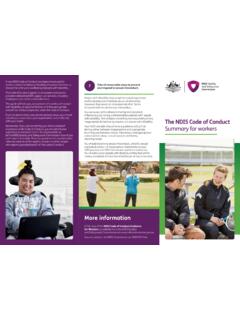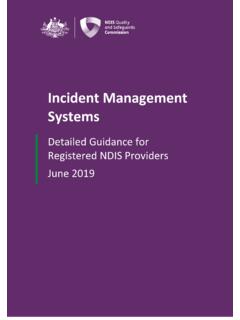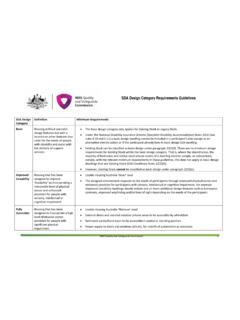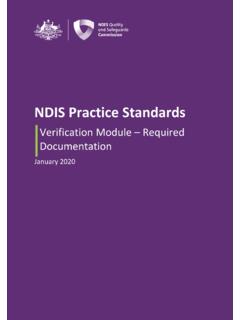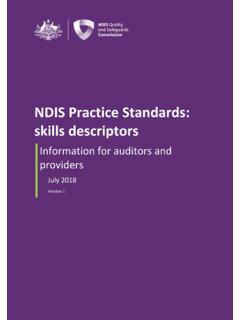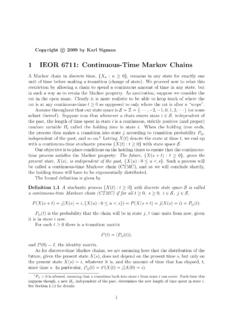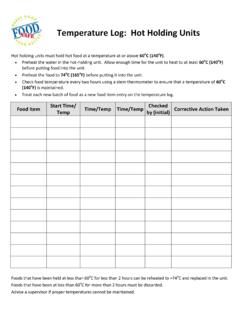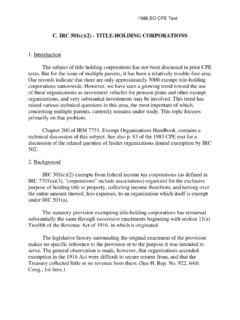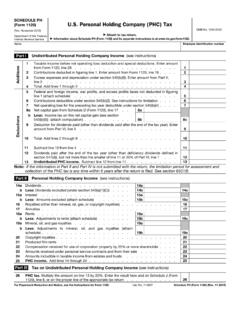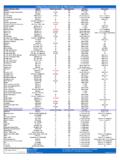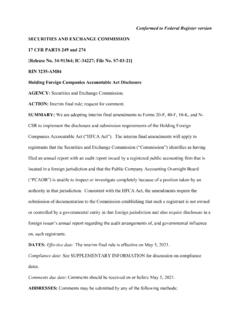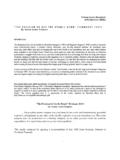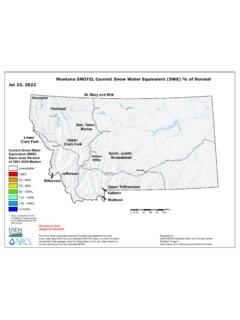Transcription of Regulated Restrictive Practices Guide
1 NDIS Quality and Safeguards Commission 1 Regulated Restrictive Practices Guide Chemical restraint Environmental restraint Mechanical restraint Physical restraint Seclusion Version 1, October 2020 NDIS Quality and Safeguards Commission 2 Acknowledgements The Regulated Restrictive Practices Guide was developed by the NDIS Quality and Safeguards Commission in consultation with: People with a lived experience of disability and their families Australian Health Practitioner Regulation Agency (AHPRA) o Occupational Therapy Australia (OTA) o Australian Psychological Society (APS) o Australian Physiotherapy Association (APA) Professor Julian Trollor, UNSW Medicine, School of Psychiatry, Department of Developmental Disability Neuropsychiatry Dr. Dinesh K Arya, Chief Medical Officer, ACT Health Directorate, Office of the Chief Psychiatrist (ACT) Australian Government Department of Social Services Policy Branch National Disability Insurance Scheme (NDIS) Representatives of the States and Territories Departments and the Senior Practitioners Practice Leadership Group including: o ACT Department of Community Services o NSW Department of Communities and Justice o Department of Health, Northern Territory Government o QLD Department of Communities, Disability Services and Seniors o Department of Human Services South Australia o Department of Communities Tasmania o Department of Health and Human Services Victoria o Department of Communities Western Australia.
2 Suggested Citation NDIS Quality and Safeguards Commission (2020). Regulated Restrictive Practices Guide . Penrith, Australia: NDIS Quality and Safeguards Commission. NDIS Quality and Safeguards Commission 3 Contents Introduction .. 4 Restrictive Practices General information .. 5 Chemical restraint .. 10 Environmental restraint .. 15 Mechanical restraint .. 18 Physical restraint .. 22 Seclusion .. 27 Further information or support .. 31 References .. 31 Appendix A: Restrictive practice protocol Detailing the Restrictive practice in the behaviour support plan .. 36 Appendix B: Chemical restraint case study .. 37 Appendix C: Chemical restraint protocol example .. 39 Appendix D: Environmental restraint case study .. 41 Appendix E: Environmental restraint protocol example .. 43 Appendix F: Mechanical restraint case study .. 45 Appendix G: Mechanical restraint protocol example.
3 47 Appendix H: Physical restraint case study .. 49 Appendix I: Physical restraint protocol example .. 52 Appendix J: Seclusion case study .. 55 Appendix K: Seclusion protocol example .. 57 NDIS Quality and Safeguards Commission 4 Introduction Background The NDIS Quality and Safeguards Commission (NDIS Commission) is a Commonwealth agency established to protect and prevent people with disability from experiencing harm arising from poor quality or unsafe supports or services under the National Disability Insurance Scheme (NDIS). This includes monitoring the use of Regulated Restrictive Practices and promoting their reduction and elimination. Purpose of this Guide The purpose of this Guide is to: a) promote the rights and inherent dignity of people with disability b) assist in identifying each Regulated Restrictive practice c) provide practice advice consistent with a positive behaviour support framework contemporary evidence informed practice, intended to reduce and eliminate the use of Restrictive Practices , and d) assist registered NDIS providers and NDIS behaviour support practitioners to meet their obligations under the National Disability Insurance Scheme Act 2013 (NDIS Act 2013) and relevant Rules.
4 Scope of the Guide This Guide was developed for registered NDIS providers and NDIS behaviour support practitioners supporting NDIS participants, but it may also be of interest to anyone who supports a person with disability. The Guide supports a contemporary positive behaviour support framework. This Guide explains what a Restrictive practice is, and sets out information on the five types of Regulated Restrictive Practices , being: chemical restraint environmental restraint mechanical restraint physical restraint seclusion. Legislative context This Guide furthers some of the NDIS Quality and Safeguards Commissioner s specific behaviour support function as set out in section 181H of the NDIS Act 2013, relevantly: The Commissioner s behaviour support function is to provide leadership in relation to behaviour support, and in the reduction and elimination of the use of Restrictive Practices , by NDIS providers, including by: (b) developing policy and guidance materials in relation to behaviour supports and the reduction and elimination of the use of Restrictive Practices ; (c) providing education, training and advice on the use of behaviour supports and the reduction and elimination of the use of Restrictive Practices .
5 NDIS Quality and Safeguards Commission 5 (e) undertaking and publishing research to inform the development and evaluation of the use of behaviour supports and to develop strategies to encourage the reduction and elimination of Restrictive Practices by NDIS providers. The NDIS Act 2013 gives effect to Australia s obligations under the Convention of the Right of People with Disabilities (CRPD). The CRPD is the first binding international human rights treaty to recognise the rights of all people with disability. Australia signed the CRPD in 2008. The NDIS Commission is committed to promoting, protecting and ensuring the full and equal enjoyment of all human rights and fundamental freedoms by people with disability and promoting respect for their inherent dignity. Restrictive Practices General information What is a Restrictive practice? Section 9 of the NDIS Act 2013 defines a Restrictive practice as any practice or intervention that has the effect of restricting the rights or freedom of movement of a person with disability.
6 Under the National Disability Insurance Scheme ( Restrictive Practices and Behaviour Support) Rules 2018, there are five Restrictive Practices that are subject to regulation and oversight by the NDIS Commission. These are chemical restraint, mechanical restraint, physical restraint, environmental restraint and seclusion. The use of Restrictive Practices for people with disability can present serious human rights breaches. The decision to use a Restrictive practice needs careful clinical and ethical consideration, taking into account a person s human rights and the right to self-determination. Restrictive Practices should be used within a positive behaviour support framework that includes proactive, person-centred and evidence-informed interventions. There are some circumstances when Restrictive Practices are necessary as a last resort to protect a person with disability and or others from harm. The NDIS Commission s role is to provide registered NDIS providers and NDIS behaviour support practitioners with clear guidance to ensure appropriate safeguards are in place with the aim of reducing and eliminating the use of Regulated Restrictive Practices where possible.
7 Under the NDIS Act 2013, if an NDIS provider, or a person employed or otherwise engaged by an NDIS provider, is found to have contravened the NDIS Act 2013 or Rules, the NDIS Quality and Safeguards Commissioner may undertake compliance and enforcement action, in a risk responsive and proportionate manner, applying the strongest actions to the most serious breaches. Non-compliance may be handled using a range of tools that are outlined in the Compliance and Enforcement NDIS Quality and Safeguards Commission Policy. NDIS Quality and Safeguards Commission 6 When can a Restrictive practice be used? The following legislative instruments outline the conditions under which Regulated Restrictive Practices can be used: National Disability Insurance Scheme ( Restrictive Practices and Behaviour Support) Rules 2018 National Disability Insurance Scheme (Provider Registration and Practice Standards) Rules 2018 National Disability Insurance Scheme (Incident Management and Reportable Incidents) Rules 2018.
8 Some of these conditions include that the use of a Regulated Restrictive practice must: a) be clearly identified in the behaviour support plan b) if the State or Territory in which the Regulated Restrictive practice is to be used has an authorisation process (however described) in relation to that practice, be authorised in accordance with that process c) be used only as a last resort in response to risk of harm to the person with disability or others, and after the provider has explored and applied evidence-based, person-centred and proactive strategies d) be the least Restrictive response possible in the circumstances to ensure the safety of the person or others e) reduce the risk of harm to the person with disability or others f) be in proportion to the potential negative consequence or risk of harm g) be used for the shortest possible time to ensure the safety of the person with disability or others.
9 Key points and general considerations about Restrictive Practices The information below includes sourced legislative requirements including the conditions of registration with the NDIS Commission. Reporting obligations and authorisation: Registered NDIS providers and NDIS behaviour support practitioners need to be aware of their reporting obligations to the NDIS Commission. They also need to follow State and Territory authorisation, consent and reporting requirements consistent with relevant legislation, policy and/or procedures. Least Restrictive : A Restrictive practice must be the least Restrictive response possible in the circumstances to ensure the safety of the person or others. Shortest time and last resort: A Restrictive practice must be used for the shortest possible time and only as a last resort after exploring and applying evidence-based, person-centred and proactive strategies. A functional behaviour assessment: This is a key component in the development of a comprehensive behaviour support plan.
10 A functional behaviour assessment is a requirement under section 20(5) of the NDIS ( Restrictive Practice and Behaviour Support) Rules 2018. Behaviour support plan: The use of a Restrictive practice must be detailed in a behaviour support plan and only used within a framework of positive behaviour support. An example of information that should be considered in detailing a Restrictive practice in a plan can be found in Appendix A: Restrictive Practice Protocol. NDIS Quality and Safeguards Commission 7 Report use: NDIS providers implementing Regulated Restrictive Practices need to keep records on their use of Restrictive Practices and report use to the NDIS Commission (NDIS ( Restrictive Practices and Behaviour Support) Rules 2018 under sections 14 and 15. Reduction and elimination: From the outset, consideration should be given on how to gradually reduce (and eliminate over time ) the use of the Restrictive practice.)


